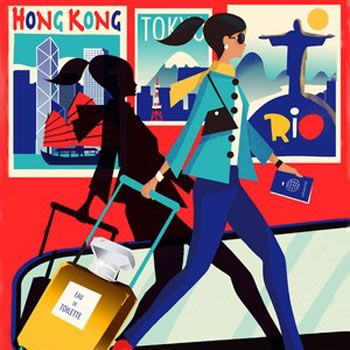Air travel is the new omnichannel, as leaps in digital technology converge with the emerging horde of global middle-class shoppers.
That is just one of the developing factors poised to spur a transformation of the far-flung travel retail industry and set a new stage for evolutionary growth of one of the most dynamic businesses in all of global beauty.
A burgeoning tide of new middle-class shoppers, rising up in the emerging markets of the world, all with a sharpening appetite for travel and luxuries, has swollen the population of air travelers to more than 1 billion. This groundswell has created a travel retail environment ripe for innovation and growth, ranging from brands diversifying their product assortments to the introduction of beauty categories such as professional hair care and dermacosmetics to a complete digital revolution in the sky with passengers buying products in their seats at 30,000 feet.
The travel retail business, or duty free as it has been called since the first airport shop opened in Ireland’s Shannon Airport in 1947, has undergone a long series of dramatic reinventions. Once known for stacked-up displays of liquor, cigarettes and fragrances – whose appeal was solely based on the depth of discounts – duty free morphed into travel retail after a change in European Union legislation in mid-1999 and was made over into an environment as sophisticated as any glittering downtown specialty store.
Today, beauty manufacturers maintain counters or wall units in multibrand shops manned by multilingual beauty advisers, who cater to travelers from different countries, and offer sharply targeted product kits and offerings tailored to a traveling audience. Some brands, like MAC Cosmetics and Kiehl’s, have their own boutiques in airports.

The world of travel retail crisscrosses the map with a global network of sales points, not only in international airports, where 57.8 percent of the total business was done in 2013, according to Sweden-based Generation Research, the industry’s sales tracking firm. The sales are also made on ferries and in downtown shops operated by travel retail operators, which have become a new dynamic channel with gains of 20 percent a year, according to industry sources. The power of the channel has always derived from the constantly increasing foot traffic of a captive audience of waiting travelers looking to kill time and with an urge to spend money.
As a result, the travel retail business often outpaces sales trends in local markets and the global business as a whole.
Even though the industry is weathering some financial turbulence with the implosion of the Russian economy, a marked slowdown in China and trouble in Latin America, sales ran ahead by 5 percent last year and are expected to increase by 7 percent this year (compared with a 3 percent to 5 percent increase for global beauty), according to Jérôme Goldberg, managing director of JMG-Research, a research and consulting company.

The category’s revenues increased 9.3 percent in 2013, when global travel retail sales of just fragrance and beauty amounted to $17.3 billion, according to Generation.
“In less than two years, we should be above $20 billion,” Goldberg says. It often has been pointed out that the travel retail market is significantly bigger – at least 64 percent larger – than the entire U.S. prestige sector, which amounted to $11.2 billion for 2014, according to The NPD Group.
In terms of fragrance alone, Goldberg observes, the duty-free market accounts for 20 percent of total global category sales. The travel business also generates 14 percent of prestige skin-care and makeup sales.
Skin care is the biggest seller, apparently pushed by the rise in Asian travelers, with 34.7 percent of total beauty sales, according to Generation. In 2013, it was followed by women’s fragrances, with 31.3 percent; men’s scents, with 17.9 percent; makeup, with 14 percent, and fragrance coffrets, with 1.8 percent.

“It’s more and more important for prestige brands to rely on this market,” Goldberg concludes, adding that for fragrance manufacturers, it can be the biggest market in the world.
The entire duty-free business – including wines and spirits, tobacco, fashion and accessories, watches and jewelry, electronics and confectioneries and food – totaled $60 billion in 2013. Beauty accounted for 28.8 percent of the total, the largest segment. “It should be around $100 billion by 2020,” Goldberg says.
Travel retail business is flourishing day by day, new middle class shoppers interest towards traveling has also increased due to the diversifications in digital revolution.



